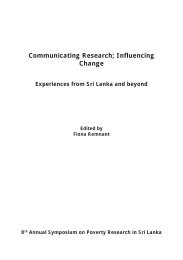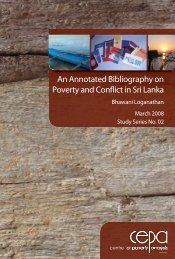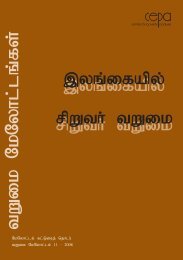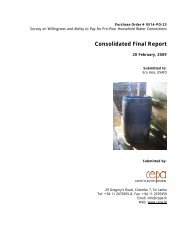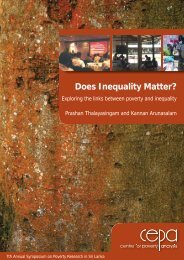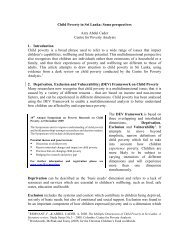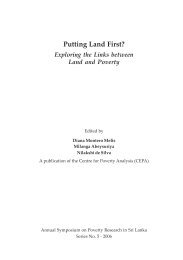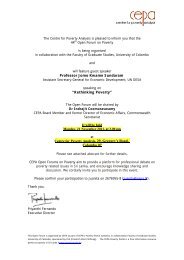Involuntary Displacement and Resettlement â Policy and ... - CEPA
Involuntary Displacement and Resettlement â Policy and ... - CEPA
Involuntary Displacement and Resettlement â Policy and ... - CEPA
- No tags were found...
You also want an ePaper? Increase the reach of your titles
YUMPU automatically turns print PDFs into web optimized ePapers that Google loves.
4 Becoming Internally Displaced <strong>and</strong> Hosts 5In October 1990, the majority of Muslims expelled by the LTTE from thenorthern areas under their control went to Puttalam district in the NorthWestern Province. The local people (particularly the Muslims, but also theSinhalese) welcomed the Muslims from the north into their homes, gardens<strong>and</strong> schools for shelter, <strong>and</strong> provided the displaced with clothes <strong>and</strong> food. Inthis process the locals became hosts. After some days <strong>and</strong> weeks, the NGOcommunity <strong>and</strong> the government moved in to assist the IDPs more actively<strong>and</strong> the hosts to a large extent withdrew their assistance. Two decades on,the IDPs are still living as IDPs in Puttalam, some on small plots of their own,some still in camps, most still with the status of internally displaced people<strong>and</strong> identities of IDPs <strong>and</strong> hosts are still strongly maintained. Although thereis much variation within them, it is interesting to underst<strong>and</strong> how thesecategories were formed <strong>and</strong> how they are maintained. Two discourses inparticular were instrumental in forming the categories; the discourse onMuslim ethics <strong>and</strong> ideals, <strong>and</strong> the humanitarian discourse on internaldisplacement (cf. UN-Brookings-Bern project).The Discourse on Islamic Ethics <strong>and</strong> IdealsThe Prophet went into exile at Medina in AD 622, a key date because it constitutesyear one of the Muslim calendar. The Meccans who migrated with him would becalled the Muhajirun (literally ‘migrants’), [...]. His new adherents, recruited fromamong the tribes of Medina, would be called the Ansar (auxiliaries, supporters). […]The simplicity of their lodgings, their closeness to each other, <strong>and</strong> their closeness tothe mosque gave a democratic dimension to the Islamic community that makes us alldream – dream about that lack of distance between the leader <strong>and</strong> ‘his people.’Thanks to the ease of exchange among the Muhajirun <strong>and</strong> the presence of themosque, the integration of the Ansar <strong>and</strong> all the other new converts proceeded withrapidity. To accelerate the amalgamation of Medinese <strong>and</strong> Meccans, Muhammad hadrecourse to some rituals that created fraternal links: each Ansari was to accept aMuhajir as ‘brother,’ for whom he was to be, as it were, responsible for ‘helping himto conquer the feeling of uprootedness’ (Mernissi 1991:30 <strong>and</strong> 111).The Islamic ethic of welcoming strangers may be traced back to the ProphetMohammad’s time; the Prophet’s flight from persecution in Mecca <strong>and</strong> hisreception in Medina were often mentioned as an important parallel to thearrival <strong>and</strong> reception of the northern Muslims in Puttalam. People comparedthe displaced people with the ‘Muhajiruns’ who had to flee, <strong>and</strong> the localswho received them with the ‘Ansaris’. The Islamic obligation to receive <strong>and</strong>5This section is based on Brun 2008 <strong>and</strong> Brun forthcoming132



